Allocation By Assignment Dimension
Description
Allocate values based on an assignment dimesion and driver data table.
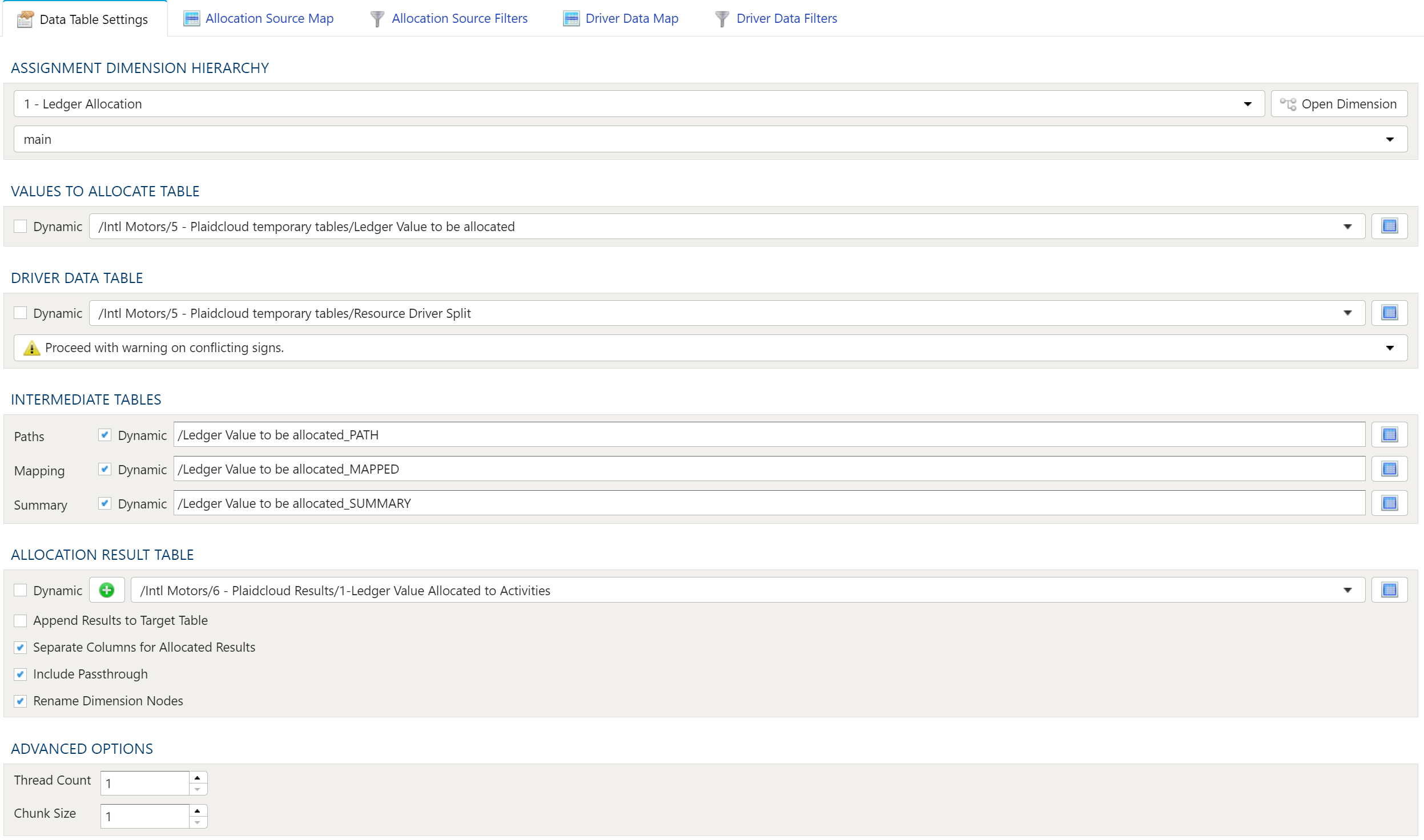
Data Table Settings
Assignment Dimesion Hierarchy

The Assignment Dimension Hierarchy gives the user the ability to point, click and filter either or both the Values To Allocate Table and Driver Data Table to create targeted allocations. The Assignment Dimension Hierarchy is created by combining dimensions that reference the Values To Allocate Table and the Driver Data Table.
Creating An Assignment Dimension Hierarchy
To create the Assignment Dimension Hierarchy you must first create the dimensions you wish to use to as filters for the Values To Allocate Table and the Driver Data Table. The links below will guide you through creating these dimensions.
Creating The Main Hierarchy
Once the dimensions for the Values To Allocate Table and the Driver Data Table have been created the next step is to decide which of the dimensions for the Values To Allocate Table will serve as the Main Hierarchy for the Assignment Dimension Hierarchy.
Copy this dimension by navigating to the Dimensions tab in PlaidCloud, clicking on the dimension and then selecting Actions and Copy Dimension. When you copy the dimension a pop-up will apprear asking you to enter a name for the copied dimension.
Adding Dimensions To The Assignment Hierarchy
Open the newley created Assignment Dimension, click on the down arrow next to Properties and select New Property.
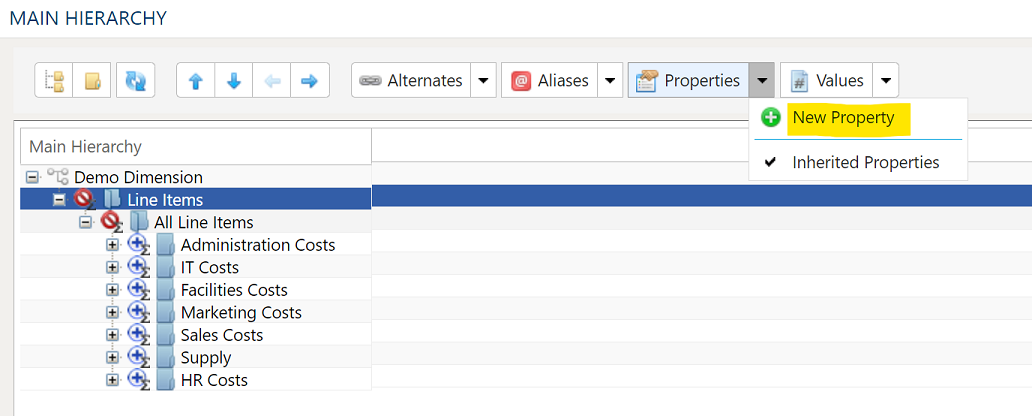
This will open the Property Configuration dialog box:
Property Configuration
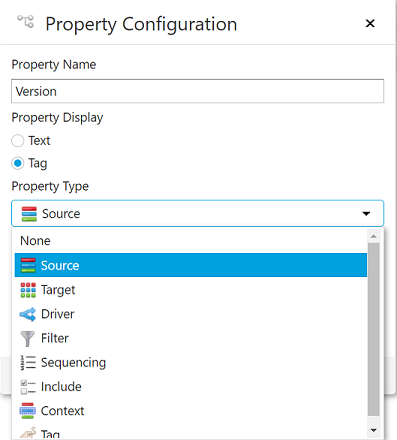
- Property Name - This is normally the name of the dimension that is being added to the Assignment Hierarchy.
- Property Display - This should be set to "Tag".
- Property Type - This property informs the allocation step which table Values To Allocate Table or the Driver Data Table this dimension is related too.
- Source - Is used in conjunction with the Values To Allocate Table.
- Target - Is used in conjunction with the Driver Data Table.
- Driver - Is used to filter Driver Data Table for the specific driver selected.
- Context - When the Values To Allocate Table and the Driver Data Table contain the same dimension then context can be used to specify how the dimensions should relate to one another. Context is often used when both the Values To Allocate Table and the Driver Data Table contain Profit / Cost Centers or Geography.
- Current - Acts as a passthrough and will filter the Driver Data Table based on the settings of the target dimension. An example would be if the Cotext is based on the Profit Center dimension and the Profit Center target dimension is set to ALL then the driver data would filter on all Profit Centers.
- Parent - When selected then the parent of the Profit Center in the Values To Allocate Table will be used to filter the driver values in the Driver Data Table. This is useful when driver values are, at times, not available for a specific Profit Center but often are at the parent level.
- All - When selected then the Profit Center in the Values To Allocate Table will not filter the driver values in the Driver Data Table, driver values for all Profit Centers will be used.Note: When Context is set to ALL or Parent it will override the setting on the target dimension.
- Editor Type - This drop down should be set to Select Dimension.
Once the appropriate properties have been selected for the dimension being added to the Assignment Hierarchy select "Edit Configuration".
Dimension Configuration
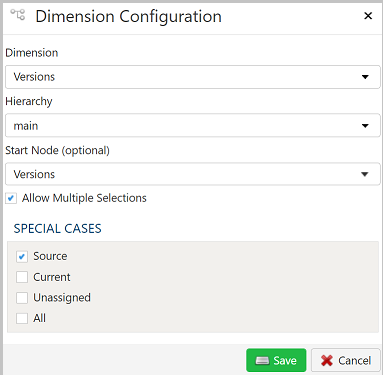
- Dimension - Use the drop down to select the dimension.
- Hierarchy - If the dimension selected has alternate hierarchies, then they will appear and be selectable here as well as the main hierarchy.
- Start Node - If you don't wish the dimension to be displayed from the top node you can select any node within the hierarchy as the node from which the dimension will be displayed.
- Allow Multiple Selections - If checked the user will be able to select multiple nodes in the hierarchy.
- Special Cases - When selected the special cases will be available for selection in the dimension drop down menu. They are typically used in Target dimensions.
- Source - When a dimension is set to Source the allocation will ignore this dimension when it filters the Driver Data Table but the allocated results will include values from the dimension.
- Current - Can be used when a dimension is shared between Source and Target. When the Target dimension is set to Current then the Driver Data Table will be filtered by the current value of the Source dimension as the allocation runs. An example would be if there are multiple periods in the Values To Allocate Table and the Driver Data Table but you want the allocation to allocate within the periods and not acrocss them. It is also common to use Current on Business Units, Cost Centers and Geographies.
- Unassigned - When a dimension is set to Unassigned the allocation will ignore this dimension when it filters the Driver Data Table and the allocation result for this dimension will be a Null value.
- All - When a dimension is set to ALL then the allocation will use all the values in the dimension.
The Values To Allocate Table, Driver Data Table and Allocation Result Table can be selected dynamically or statically.
Dynamic Table Selection
The dynamic table option allows specification of a table using text and variables. This is useful when employing variable driven workflows where the table or view references are relative to the variables specified.
An example that uses the current_month variable to dynamically point to a table:
legal_entity/inputs/{current_month}/ledger_values
Static Table Selection
When a specific table is desired as the source, leave the Dynamic box unchecked and select the source table using the dropdown menu.
Table Explorer is always avaible with any table selection. Click on the Table Explorer button to the right of the table selection and a Table Explorer window will open.
Values To Allocate Table
This is the table that contains the values that are to be allocated. These are typically cost or revenue values.
Driver Data Table
The driver data table contains the values that the allocation step will use to allocate costs.
Examples:
- For a supply chain to assign costs to customers you might use delivery data with the number of deliveries or the weight of the deliveries as the driver.
- For an IT help desk to assign its costs to the departments it supports the driver data be the number of tickets by cost center.
Driver Data Sign Rule
Driver data can contain both positive and negative values. The Driver Data Sign Rule lets you decide how conflicting signs will be handled.
- Error on conficting signs - Allocation step will produce an error and stop if conflicting signs are encountered.
- Proceed with warning on conflicting signs - Allocation step will use both negative and positive driver values but will display a warning.
- Use only positive driver values - Allocation step will only use positive driver values, will ignore negative values.
- Use only negative driver values - Allocation step will only use negative driver values, will ignore positive values.
- Use absolute values of driver data - Allocation step will use the absolute values of the driver data.
Intermediate Tables
The Intermediate Tables are created each time an allocation step runs and provides a summary of the allocation processing. The Intermediate Tables provide insight into how the alloation process is running an are used to trouble shoot unexpected results.
- Paths - Shows the number of unique allocation paths summarized from the assignment hierarchy.
- Mapping - Shows how each line of the Values To Allocate Table are mapped to the allocation targets.
- Summary - Shows each rule, as a result of the assignment hierachy, and how many of the records from the Values To Allocate Table match it.
Allocation Result Table
Append Results to Target Table
If this box is checked the allocation results will be appended to the allocation result table. If this box is not checked the allocation results table will be overwritten each time the allocation step runs.
Separate Columns for Allocated Results
If this box is checked then the results table will show the amount of each allocated record as well as the amount actually allocated to each driver record.
Rename Dimension Nodes
If this box is checked when the allocation step runs it will rename the dimension node in the Assignment dimension.
Advanced Options
Thread Count
Sets the number of concurrent operations the allocation step will use.
Chunk Size
Set the number of allocation paths within a thread.
Allocation Source Map

The Allocation Source Map is used to map the columns from the Values To Allocate Table that will be used in the allocation step.
Inspection and Populating the Mapper
Using the Inspect Source menu button provides additional ways to map columns from source to target:
- Populate Both Mapping Tables: Propagates all values from the source data table into the target data table. This is done by default.
- Populate Source Mapping Table Only: Maps all values in the source data table only. This is helpful when modifying an existing workflow when source column structure has changed.
- Populate Target Mapping Table Only: Propagates all values into the target data table only.
If the source and target column options aren’t enough, other columns can be added into the target data table in several different ways:
- Propagate All will insert all source columns into the target data table, whether they already existed or not.
- Propagate Selected will insert selected source column(s) only.
- Right click on target side and select Insert Row to insert a row immediately above the currently selected row.
- Right click on target side and select Append Row to insert a row at the bottom (far right) of the target data table.
Role
Each column in the data mapper must be assigned a role:
- Pass Thought - These columns will appear in the allocation results table.
- Value to Allocate - This is the column that contains the values to be allocated.
Deleting Columns
To delete columns from the target data table, select the desired column(s), then right click and select Delete.
Changing Column Order
To rearrange columns in the target data table, select the desired column(s). You can use either:
- Bulk Move Arrows: Select the desired move option from the arrows in the upper right
- Context Menu: Right clikc and select Move to Top, Move Up, Move Down, or Move to Bottom.
Reduce Result to Distinct Records Only
To return only distinct options, select the Distinct menu option. This will toggle a set of checkboxes for each column in the source. Simply check any box next to the corresponding column to return only distinct results.
Depending on the situation, you may want to consider use of Summarization instead.
The distinct process retains the first unique record found and discards the rest. You may want to apply a sort on the data if it is important for consistency between runs.
Aggregation and Grouping
To aggregate results, select the Summarize menu option. This will toggle a set of select boxes for each column in the target data table. Choose an appropriate summarization method for each column.
- Group By
- Sum
- Min
- Max
- First
- Last
- Count
- Count (including nulls)
- Mean
- Standard Deviation
- Sample Standard Deviation
- Population Standard Deviation
- Variance
- Sample Variance
- Population Variance
- Advanced Non-Group_By
For advanced data mapper usage such as expressions, cleaning, and constants, please see the Advanced Data Mapper Usage
Allocation Source Filters

To allow for maximum flexibility, data filters are available on the source data and the target data. For larger data sets, it can be especially beneficial to filter out rows on the source so the remaining operations are performed on a smaller data set.
Select Subset Of Data
This filter type provides a way to filter the inbound source data based on the specified conditions.
Apply Secondary Filter To Result Data
This filter type provides a way to apply a filter to the post-transformed result data based on the specified conditions. The ability to apply a filter on the post-transformed result allows for exclusions based on results of complex calcuations, summarizaitons, or window functions.
Final Data Table Slicing (Limit)
The row slicing capability provides the ability to limit the rows in the result set based on a range and starting point.
Filter Syntax
The filter syntax utilizes Python SQLAlchemy which is the same syntax as other expressions.
View examples and expression functions in the Expressions area.
Driver Data Map

The Allocation Driver Data Map is used to map the columns from the Driver Data Table that will be used in the allocation step.
Inspection and Populating the Mapper
Using the Inspect Source menu button provides additional ways to map columns from source to target:
- Populate Both Mapping Tables: Propagates all values from the source data table into the target data table. This is done by default.
- Populate Source Mapping Table Only: Maps all values in the source data table only. This is helpful when modifying an existing workflow when source column structure has changed.
- Populate Target Mapping Table Only: Propagates all values into the target data table only.
If the source and target column options aren’t enough, other columns can be added into the target data table in several different ways:
- Propagate All will insert all source columns into the target data table, whether they already existed or not.
- Propagate Selected will insert selected source column(s) only.
- Right click on target side and select Insert Row to insert a row immediately above the currently selected row.
- Right click on target side and select Append Row to insert a row at the bottom (far right) of the target data table.
Role
Each column in the data mapper must be assigned a role:
- Source Relation - These columns have corresponing columns in the Values To Allocate Table.
- Allocation Target - The columns will be the target of the allocation step and will appear in the Allocation Result Table.
- Split Value - This column contains the values that will be used to allocate the values in the Values To Allocate Table.
Deleting Columns
To delete columns from the target data table, select the desired column(s), then right click and select Delete.
Changing Column Order
To rearrange columns in the target data table, select the desired column(s). You can use either:
- Bulk Move Arrows: Select the desired move option from the arrows in the upper right
- Context Menu: Right clikc and select Move to Top, Move Up, Move Down, or Move to Bottom.
Reduce Result to Distinct Records Only
To return only distinct options, select the Distinct menu option. This will toggle a set of checkboxes for each column in the source. Simply check any box next to the corresponding column to return only distinct results.
Depending on the situation, you may want to consider use of Summarization instead.
The distinct process retains the first unique record found and discards the rest. You may want to apply a sort on the data if it is important for consistency between runs.
Aggregation and Grouping
To aggregate results, select the Summarize menu option. This will toggle a set of select boxes for each column in the target data table. Choose an appropriate summarization method for each column.
- Group By
- Sum
- Min
- Max
- First
- Last
- Count
- Count (including nulls)
- Mean
- Standard Deviation
- Sample Standard Deviation
- Population Standard Deviation
- Variance
- Sample Variance
- Population Variance
- Advanced Non-Group_By
For advanced data mapper usage such as expressions, cleaning, and constants, please see the Advanced Data Mapper Usage
Driver Data Filters

To allow for maximum flexibility, data filters are available on the source data and the target data. For larger data sets, it can be especially beneficial to filter out rows on the source so the remaining operations are performed on a smaller data set.
Select Subset Of Data
This filter type provides a way to filter the inbound source data based on the specified conditions.
Apply Secondary Filter To Result Data
This filter type provides a way to apply a filter to the post-transformed result data based on the specified conditions. The ability to apply a filter on the post-transformed result allows for exclusions based on results of complex calcuations, summarizaitons, or window functions.
Final Data Table Slicing (Limit)
The row slicing capability provides the ability to limit the rows in the result set based on a range and starting point.
Filter Syntax
The filter syntax utilizes Python SQLAlchemy which is the same syntax as other expressions.
View examples and expression functions in the Expressions area.
Examples
Example 1
Values To Allocate Table

Driver Data Table

Assignment Dimension Hierarchy
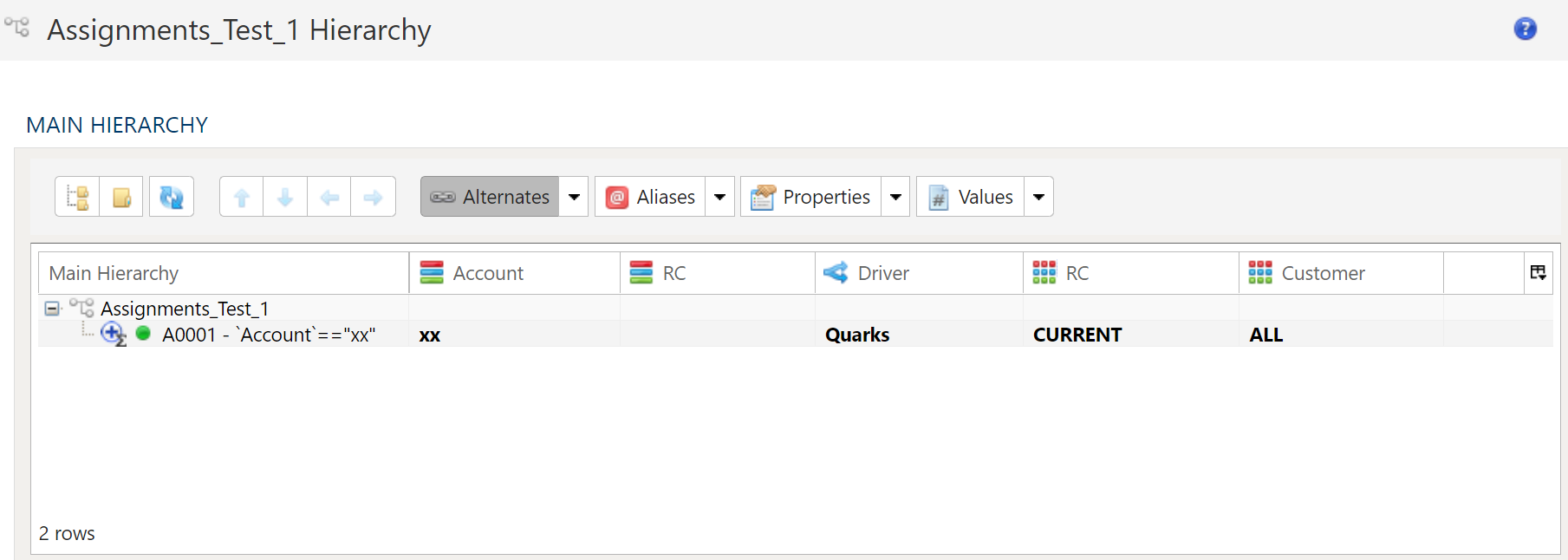
Since the Target RC dimension is set to Current the driver data will be filtered by the Source RC values in the Values To Allocation Table. Since the only value in the Source RC is "A", only the driver value records where RC = A will be used in the allocation step.
Allocation Results Table

Example 2
Values To Allocate Table

Driver Data Table

Assignment Dimension Hierarchy
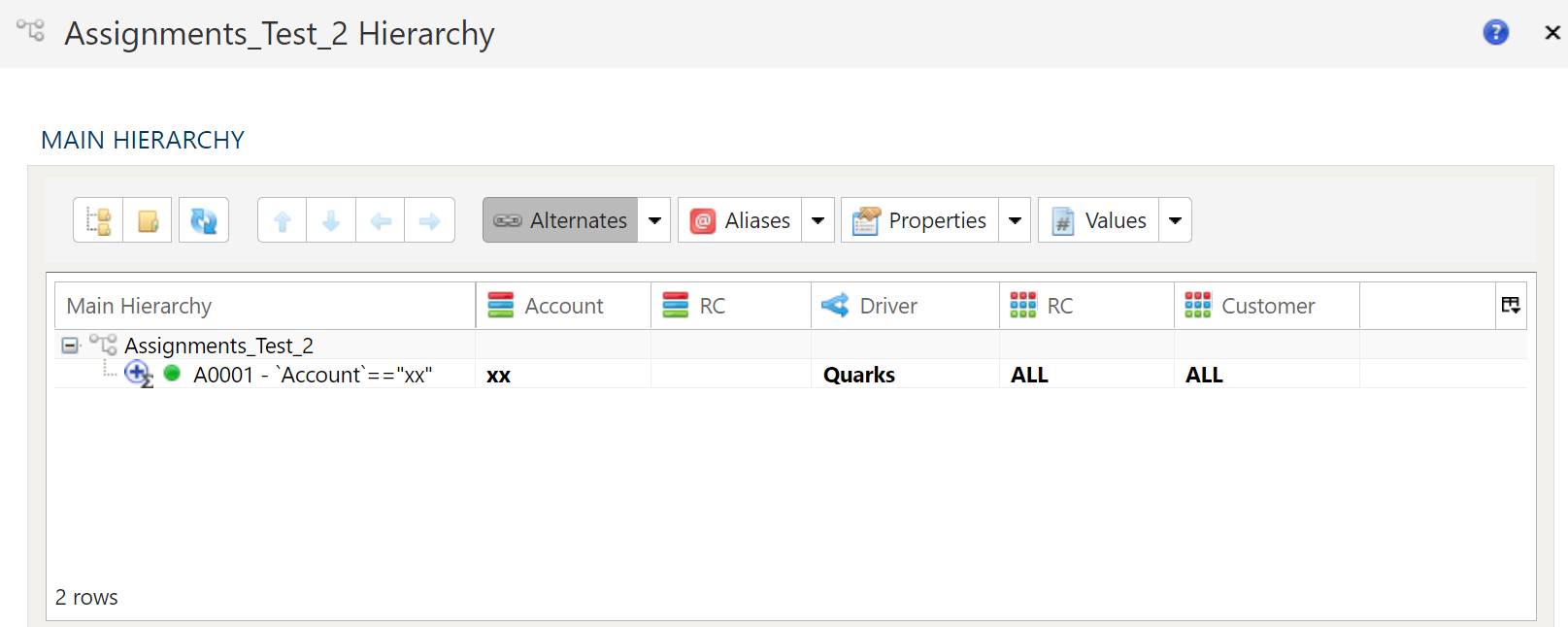
Since the Target RC dimension is set to ALL the driver data will include all RC values as you can see in the RC column in the Allocation Results Table.
Allocation Results Table

Example 3
Values To Allocate Table

Driver Data Table

Assignment Dimension Hierarchy

With the Context RC set to ALL and the Target RC set to Source the driver data will include all the RC in the driver data. The Contect RC will override the setting on the Target RC.
Allocation Results Table

Example 4
Values To Allocate Table

Driver Data Table

Assignment Dimension Hierarchy

With the Context RC set to ALL the driver data will include all the RC in the driver data.
Allocation Results Table
